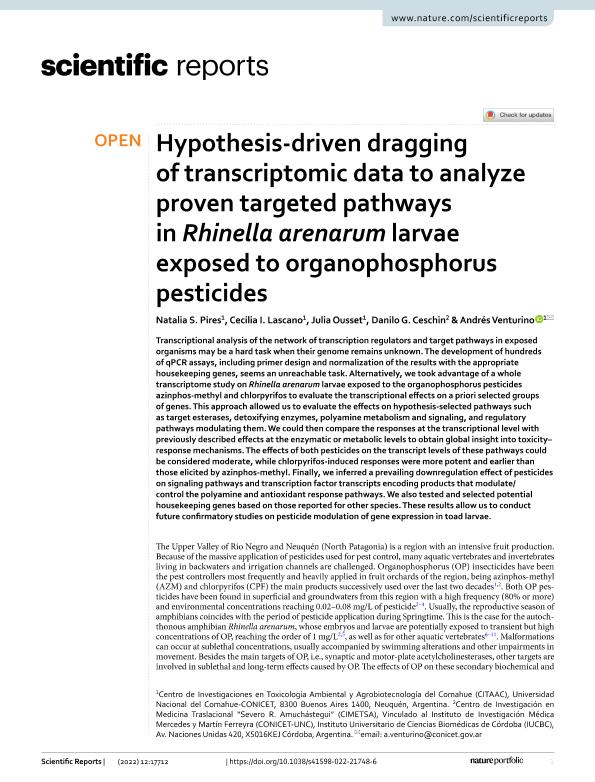Mostrar el registro sencillo del ítem
dc.contributor.author
Pires, Natalia Susana

dc.contributor.author
Lascano, Cecilia Ines

dc.contributor.author
Ousset, Maria Julia

dc.contributor.author
Ceschin, Danilo Guillermo

dc.contributor.author
Venturino, Andres

dc.date.available
2023-07-04T17:36:23Z
dc.date.issued
2022-12
dc.identifier.citation
Pires, Natalia Susana; Lascano, Cecilia Ines; Ousset, Maria Julia; Ceschin, Danilo Guillermo; Venturino, Andres; Hypothesis-driven dragging of transcriptomic data to analyze proven targeted pathways in Rhinella arenarum larvae exposed to organophosphorus pesticides; Nature Publishing Group; Scientific Reports; 12; 1; 12-2022; 1-15
dc.identifier.issn
2045-2322
dc.identifier.uri
http://hdl.handle.net/11336/202312
dc.description.abstract
Transcriptional analysis of the network of transcription regulators and target pathways in exposed organisms may be a hard task when their genome remains unknown. The development of hundreds of qPCR assays, including primer design and normalization of the results with the appropriate housekeeping genes, seems an unreachable task. Alternatively, we took advantage of a whole transcriptome study on Rhinella arenarum larvae exposed to the organophosphorus pesticides azinphos-methyl and chlorpyrifos to evaluate the transcriptional effects on a priori selected groups of genes. This approach allowed us to evaluate the effects on hypothesis-selected pathways such as target esterases, detoxifying enzymes, polyamine metabolism and signaling, and regulatory pathways modulating them. We could then compare the responses at the transcriptional level with previously described effects at the enzymatic or metabolic levels to obtain global insight into toxicity–response mechanisms. The effects of both pesticides on the transcript levels of these pathways could be considered moderate, while chlorpyrifos-induced responses were more potent and earlier than those elicited by azinphos-methyl. Finally, we inferred a prevailing downregulation effect of pesticides on signaling pathways and transcription factor transcripts encoding products that modulate/control the polyamine and antioxidant response pathways. We also tested and selected potential housekeeping genes based on those reported for other species. These results allow us to conduct future confirmatory studies on pesticide modulation of gene expression in toad larvae.
dc.format
application/pdf
dc.language.iso
eng
dc.publisher
Nature Publishing Group

dc.rights
info:eu-repo/semantics/openAccess
dc.rights.uri
https://creativecommons.org/licenses/by/2.5/ar/
dc.subject
Rhinella arenarum
dc.subject
Toxicogenomic
dc.subject.classification
Bioquímica y Biología Molecular

dc.subject.classification
Ciencias Biológicas

dc.subject.classification
CIENCIAS NATURALES Y EXACTAS

dc.title
Hypothesis-driven dragging of transcriptomic data to analyze proven targeted pathways in Rhinella arenarum larvae exposed to organophosphorus pesticides
dc.type
info:eu-repo/semantics/article
dc.type
info:ar-repo/semantics/artículo
dc.type
info:eu-repo/semantics/publishedVersion
dc.date.updated
2023-07-04T10:55:12Z
dc.journal.volume
12
dc.journal.number
1
dc.journal.pagination
1-15
dc.journal.pais
Reino Unido

dc.journal.ciudad
Londres
dc.description.fil
Fil: Pires, Natalia Susana. Consejo Nacional de Investigaciones Científicas y Técnicas. Centro Científico Tecnológico Conicet - Patagonia Confluencia. Centro de Investigaciones en Toxicología Ambiental y Agrobiotecnología del Comahue. Instituto de Biotecnología Agropecuaria del Comahue | Universidad Nacional del Comahue. Facultad de Ciencias Agrarias. Centro de Investigaciones en Toxicología Ambiental y Agrobiotecnología del Comahue. Instituto de Biotecnología Agropecuaria del Comahue; Argentina
dc.description.fil
Fil: Lascano, Cecilia Ines. Consejo Nacional de Investigaciones Científicas y Técnicas. Centro Científico Tecnológico Conicet - Patagonia Confluencia. Centro de Investigaciones en Toxicología Ambiental y Agrobiotecnología del Comahue. Instituto de Biotecnología Agropecuaria del Comahue | Universidad Nacional del Comahue. Facultad de Ciencias Agrarias. Centro de Investigaciones en Toxicología Ambiental y Agrobiotecnología del Comahue. Instituto de Biotecnología Agropecuaria del Comahue; Argentina
dc.description.fil
Fil: Ousset, Maria Julia. Consejo Nacional de Investigaciones Científicas y Técnicas. Centro Científico Tecnológico Conicet - Patagonia Confluencia. Centro de Investigaciones en Toxicología Ambiental y Agrobiotecnología del Comahue. Instituto de Biotecnología Agropecuaria del Comahue | Universidad Nacional del Comahue. Facultad de Ciencias Agrarias. Centro de Investigaciones en Toxicología Ambiental y Agrobiotecnología del Comahue. Instituto de Biotecnología Agropecuaria del Comahue; Argentina
dc.description.fil
Fil: Ceschin, Danilo Guillermo. Consejo Nacional de Investigaciones Científicas y Técnicas. Centro Científico Tecnológico Conicet - Córdoba. Instituto de Investigación Médica Mercedes y Martín Ferreyra. Grupo Vinculado Centro de Investigación en Medicina Traslacional Severo R. Amuchástegui - Cimetsa | Universidad Nacional de Córdoba. Instituto de Investigación Médica Mercedes y Martín Ferreyra. Grupo Vinculado Centro de Investigación en Medicina Traslacional Severo R. Amuchástegui - Cimetsa | Instituto de Investigación Médica Mercedes y Martín Ferreyra. Instituto de Investigación Médica Mercedes y Martín Ferreyra. Grupo Vinculado Centro de Investigación en Medicina Traslacional Severo R. Amuchástegui - Cimetsa; Argentina
dc.description.fil
Fil: Venturino, Andres. Consejo Nacional de Investigaciones Científicas y Técnicas. Centro Científico Tecnológico Conicet - Patagonia Confluencia. Centro de Investigaciones en Toxicología Ambiental y Agrobiotecnología del Comahue. Instituto de Biotecnología Agropecuaria del Comahue | Universidad Nacional del Comahue. Facultad de Ciencias Agrarias. Centro de Investigaciones en Toxicología Ambiental y Agrobiotecnología del Comahue. Instituto de Biotecnología Agropecuaria del Comahue; Argentina
dc.journal.title
Scientific Reports
dc.relation.alternativeid
info:eu-repo/semantics/altIdentifier/url/https://www.nature.com/articles/s41598-022-21748-6
dc.relation.alternativeid
info:eu-repo/semantics/altIdentifier/doi/https://doi.org/10.1038/s41598-022-21748-6
Archivos asociados
